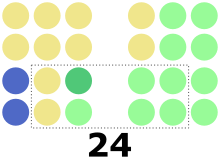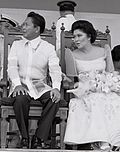This list of presidential elections in the Philippines includes election results of both presidential and vice presidential elections since 1899 with the candidates' political party and their corresponding percentage.
The following is the official canvassing of votes by the Congress of the Philippines for the 1992 Philippine presidential and vice presidential election. The canvassing started on May 26, 1992 and finished on June 16, 1992.

The 1969 Philippine presidential and vice presidential elections were held on November 11, 1969. Incumbent President Ferdinand Marcos won a second full term as President of the Philippines. Marcos was the last president in the entire electoral history of the Philippines who ran for and won a second term. His running mate, incumbent Vice President Fernando Lopez, was also elected to a third full term as Vice President of the Philippines. A total of twelve candidates ran for president, but ten of those got less than 0.01% of the vote.

The 1965 Philippine presidential and vice presidential elections were held on November 9, 1965. Incumbent President Diosdado Macapagal lost his opportunity to get a second full term as president of the Philippines to Senate President Ferdinand Marcos. His running mate, Senator Gerardo Roxas, lost to former vice president Fernando Lopez. Emmanuel Pelaez, who resigned in the Cabinet and from the Liberal Party, then sought the Nacionalista Party presidential nomination and lost it to Marcos, did not run for vice president and instead ran in the House of Representatives as an independent. An unprecedented twelve candidates ran for president; however, nine of those won 200 votes or less.

The 1961 Philippine presidential and vice presidential elections were held on November 14, 1961. Incumbent president Carlos P. Garcia lost his opportunity for a second full term as president of the Philippines to Vice President Diosdado Macapagal. His running mate, Senator Gil J. Puyat, lost to Senator Emmanuel Pelaez. Six candidates ran for president, four of whom got nine votes nationwide together. This was the only election in Philippine electoral history in which a vice-president defeated the incumbent president.

The 1957 Philippine presidential and vice presidential elections were held on November 12, 1957. Incumbent President and Vice President to Ramon Magsaysay, Carlos P. Garcia was elected for a full term as President of the Philippines. Garcia assumed the post following the death of Magsaysay in a plane crash earlier that year. His running mate, Speaker Jose Laurel Jr., lost to Pampanga Representative Diosdado Macapagal. This was the first time in Philippine electoral history wherein a president was elected by a plurality rather than a majority, and in which the winning presidential and vice presidential candidates came from different parties.

The 1953 Philippine presidential and vice presidential elections were held on November 10, 1953. Former Defense Secretary Ramon Magsaysay was elected President of the Philippines, defeating Incumbent Elpidio Quirino in his run for a second full term. His running mate Senator Carlos P. Garcia defeated Quirino's running mate Senator José Yulo. Incumbent Vice President Fernando Lopez did not run for re-election. With Magsaysay's election as president, he became the first elected president that did not come from the Senate.

The 1949 Philippine presidential and vice presidential elections were held on November 8, 1949. Incumbent President Elpidio Quirino won a full term as President of the Philippines after the death of President Manuel Roxas in 1948. His running mate, Senator Fernando Lopez, won as Vice President. Despite factions created in the administration party, Quirino won a satisfactory vote from the public. It was the only time in Philippine history where the duly elected president, vice president and senators all came from the same party, the Liberal Party. Carlos P. Romulo and Marvin M. Gray, publisher of the Manila Evening News, accuse Quirino in their book The Magsaysay Story of widespread fraud and intimidation of the opposition by military action, calling it the "dirty election".
Presidential, legislative, and local elections were held on November 8, 1949 in the Philippines. Incumbent President Elpidio Quirino won a full term as President of the Philippines after the death of President Manuel Roxas in 1948. His running mate, Senator Fernando Lopez won as Vice President. Despite factions created in the administration party, Quirino won a satisfactory vote from the public. It was the only time in Philippine history where the duly elected president, vice president and senators all came from the same party, the Liberal Party.
Presidential, legislative and local elections were held on November 10, 1953 in the Philippines. Incumbent President Elpidio Quirino lost his opportunity to get a second full term as President of the Philippines to former Defense Secretary Ramon Magsaysay. His running mate, Senator Jose Yulo lost to Senator Carlos P. Garcia. Vice President Fernando Lopez did not run for re-election. This was the first time that an elected president did not come from the Senate. This election also saw the involvement of the United States with the Central Intelligence Agency (CIA) with agent Edward Lansdale running Magsaysay's campaign. Other candidates competed for CIA support too and many normal Filipinos were interested in what the United States citizens views were on it.
Presidential, legislative and local elections were held on November 12, 1957 in the Philippines. Incumbent President Carlos P. Garcia won his opportunity to get a full term as President of the Philippines after the death of President Ramon Magsaysay in a plane crash in March 1957. His running mate, Senator Jose Laurel, Jr. lost to Pampanga Representative Diosdado Macapagal. This was the first time in Philippine electoral history where a president was elected by a plurality and not majority, and in which the president and vice president came from different parties.
Presidential, legislative and local elections were held on November 14, 1961 in the Philippines. Incumbent President Carlos P. Garcia lost his opportunity for a second full term as President of the Philippines to Vice President President Diosdado Macapagal. His running mate, Senator Gil J. Puyat lost to Senator Emmanuel Pelaez. Independent Candidate Cebu City Mayor Sergio Osmeña, Jr. ran for Vice President also lost by a narrow margin. Six candidates ran for president, four of whom were "nuisance" candidates. This was the only election in Philippine electoral history in which a vice-president defeated the incumbent president.
Presidential, legislative and local elections were held on November 11, 1969, in the Philippines. Incumbent President Ferdinand Marcos won an unprecedented second full term as President of the Philippines. Marcos was the last president in the entire electoral history who ran and won for a second term. His running mate, incumbent Vice President Fernando Lopez was also elected to a third full term as Vice President of the Philippines. An unprecedented twelve candidates ran for president, however ten of those were nuisance candidates.

Presidential and vice presidential elections, legislative elections and local elections were held in the Philippines on May 11, 1992. An estimated 80,000 candidates ran for 17,000 posts from the presidency down to municipal councillors in the first general election under the 1987 Constitution. Even though she was permitted by the Constitution to run for a second term, President Corazon Aquino did not stand for re-election.

Presidential elections, legislative and local elections were held in the Philippines on May 11, 1998. In the presidential election, Vice President Joseph Estrada won a six-year term as president by a landslide victory. In the vice-presidential race, Senator Gloria Macapagal Arroyo won a six-year term as vice president also by a landslide victory. This was the third election where both president and vice president came from different parties.
The following is the official canvassing of votes by the Congress of the Philippines for the 1957 Philippine presidential election.
The following is the official canvassing of votes by the Congress of the Philippines for the 1969 Philippine presidential election.
The following is the official canvassing of votes by the Congress of the Philippines for the 1953 Philippine presidential election.
The following is the official canvassing of votes by the Congress of the Philippines for the 1961 Philippine presidential election. The canvassing started on December 12, 1961, and ended on December 13, 1961.
The following is the official canvassing of votes by the Congress of the Philippines for the 1965 Philippine presidential election.











